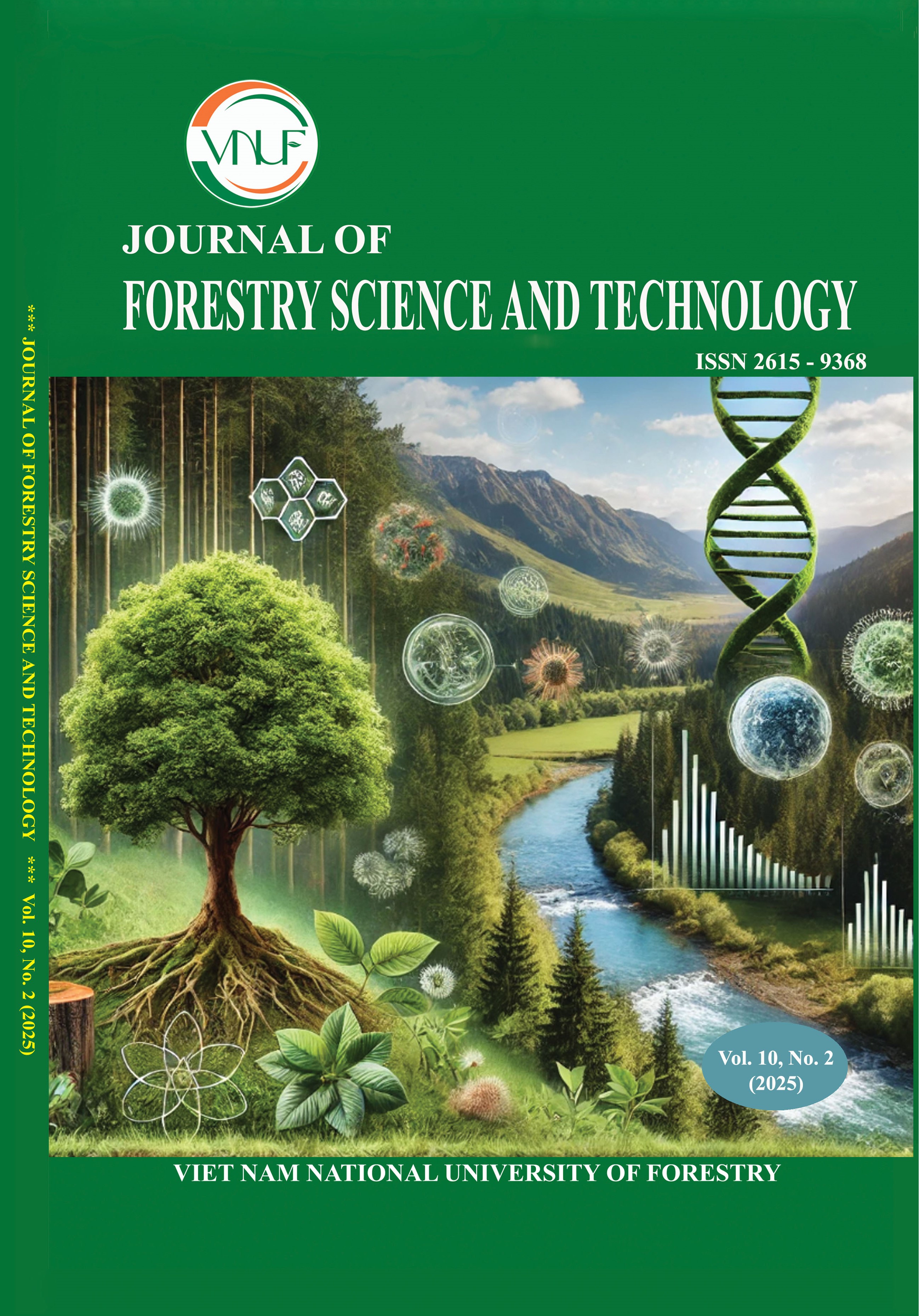Comparison of selected soil properties and soil organic carbon accumulation under different agroforestry models in Muong E and Nam Lau communes, Son La province
DOI:
https://doi.org/10.55250/Jo.vnuf.10.2.2025.040-049Keywords:
Agroforestry, carbon sequestration, ferralsol, organic matter, soil organic carbon, Son LaAbstract
Nghiên cứu này đánh giá tác động của sáu mô hình nông lâm kết hợp (AF) lên các đặc tính lý hóa đất và tích lũy cacbon hữu cơ trong đất (SOC) tại hai xã Mường Ê và Nậm Lâu, tỉnh Sơn La, miền Bắc Việt Nam. Các hệ thống AF bao gồm Michelia mediocris + chè , Zanthoxylum rhetsa + cà phê , Zanthoxylum rhetsa + chè , Canarium tramdenum + cà phê , Macadamia integrifolia + chè , và Camellia sinensis hoặc Coffea arabica độc canh làm đối chứng. Các chỉ số thực địa như sinh trưởng cây trồng, độ che phủ tán, sinh khối thảm mục, độ pH đất, độ ẩm, dinh dưỡng khả dụng, mật độ khối, chất hữu cơ và trữ lượng SOC đã được phân tích ở hai độ sâu (0-20 cm và >20-40 cm). Kết quả cho thấy các mô hình AF cải thiện đáng kể chất lượng đất so với độc canh, với độ pH đất dao động từ 5,1-5,5, độ ẩm đất thường cao hơn 2–3 lần so với độc canh, chất hữu cơ 2,81-4,68%, khối lượng riêng 1,21-1,35 g cm⁻³ và trữ lượng SOC 8,07–14,11 t ha⁻¹ - cao hơn khoảng 2-3 lần so với độc canh. Các mô hình M. mediocris + chè , Z. rhetsa + cà phê và C. tramdenum + cà phê hoạt động tốt nhất, phản ánh lượng chất độn chuồng cao hơn, khả năng giữ ẩm tốt hơn và chu trình dinh dưỡng được tăng cường. Những phát hiện này khẳng định rằng các hệ thống AF không chỉ cải thiện độ phì nhiêu của đất mà còn góp phần cô lập carbon và kiểm soát xói mòn trên đất Ferralsols dốc. Nghiên cứu cung cấp bằng chứng khoa học để thúc đẩy nông lâm kết hợp như một chiến lược sử dụng đất bền vững nhằm khôi phục năng suất đất và tăng cường khả năng phục hồi khí hậu ở các vùng cao phía bắc Việt Nam.
References
[1]. Montagnini, F. & Nair, P. K. R. (2004). Carbon sequestration: An underexploited environmental benefit of agroforestry systems. Agroforestry Systems. 61(1-3): 281-295.
DOI: 10.1023/B:AGFO.0000029005.92691.79 DOI: https://doi.org/10.1023/B:AGFO.0000029005.92691.79
[2]. Hairiah, K., Sitompul, S. M., van Noordwijk, M. & Palm, C. (2001). Methods for sampling carbon stocks above and below ground. International Centre for Research in Agroforestry (ICRAF), Bogor, Indonesia.
[3]. FAO/ISRIC/ISSS. (2006). World Reference Base for Soil Resources 2006: A Framework for International Classification, Correlation and Communication. World Soil Resources Reports No. 103, FAO, Rome.
[4]. Mutuo, P. K., Cadisch, G., Albrecht, A., Palm, C. A. & Verchot, L. (2005). Potential of agroforestry for carbon sequestration and mitigation of greenhouse gas emissions from soils in the tropics. Nutrient Cycling in Agroecosystems. 71(1): 43–54.
DOI: 10.1007/s10705-004-5285-6 DOI: https://doi.org/10.1007/s10705-004-5285-6
[5]. Frazer, G. W., Canham, C. D. & Lertzman, K. P. (1999). Gap Light Analyzer (GLA), Version 2.0: Imaging software to extract canopy structure and gap light transmission indices from true-colour fisheye photographs. Simon Fraser University, Burnaby, BC, and the Institute of Ecosystem Studies, Millbrook, NY.
[6]. CIAT (Centro Internacional de Agricultura Tropical) (2001). Laboratory Methods for Soil and Plant Analysis: A Working Manual. CIAT, Cali, Colombia.
[7]. Nguyen Van Hung & Tran Quang Binh (2018). Soil organic carbon stocks under different land uses in the Northwest of Vietnam. Vietnam Journal of Agricultural Sciences. 16(4): 512–520.
[8]. Ngo Tuan Dung, Nguyen Van Hung & Pham Hong Thai (2019). Effects of some agroforestry models on soil fertility and organic carbon accumulation in the Northwestern region of Vietnam. Vietnam Journal of Forest Science. 2: 22-32.
[9]. IPCC (Intergovernmental Panel on Climate Change) (2006). 2006 IPCC Guidelines for National Greenhouse Gas Inventories. Volume 4: Agriculture, Forestry and Other Land Use (AFOLU). Institute for Global Environmental Strategies (IGES), Japan.
[10]. Sileshi, G. W., Akinnifesi, F. K., Ajayi, O. C. & Place, F. (2008). Meta-analysis of maize yield response to gliricidia and pigeonpea legume fallows in sub-Saharan Africa. Plant and Soil. 307(1–2): 1-19. DOI: https://doi.org/10.1007/s11104-008-9547-y
DOI: 10.1007/s11104-008-9557-y
[11]. Ngo Tuan Dung, Nguyen Van Hung & Le Thi Hong (2019). Impacts of agroforestry models on soil quality in Son La province, Vietnam. Vietnam Journal of Forest Science. 9(3): 76–85.
[12]. Nair, P. K. R., Kumar, B. M. & Nair, V. D. (2010). Carbon sequestration in agroforestry systems. Advances in Agronomy. 108: 237–307.
DOI: 10.1016/S0065-2113(10)08005-3 DOI: https://doi.org/10.1016/S0065-2113(10)08005-3
[13]. Nguyen Thi Thu Hang & Le Dinh Dung (2016). Effect of land-use conversion on soil carbon stocks in the Northern midlands of Vietnam. Journal of Soil Science and Environmental Management. 7(4): 53–61.
DOI: 10.5897/JSSEM2016.0575









